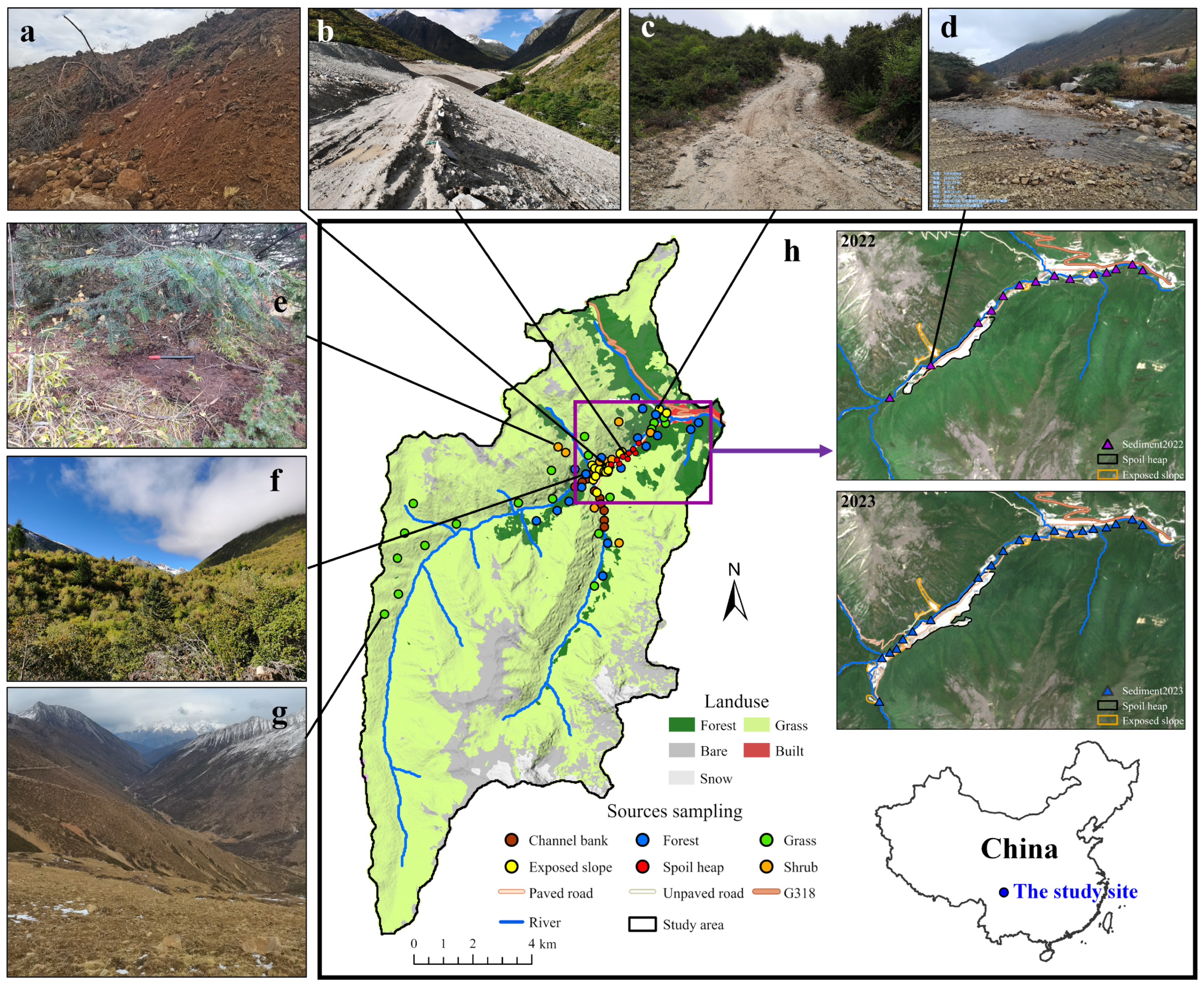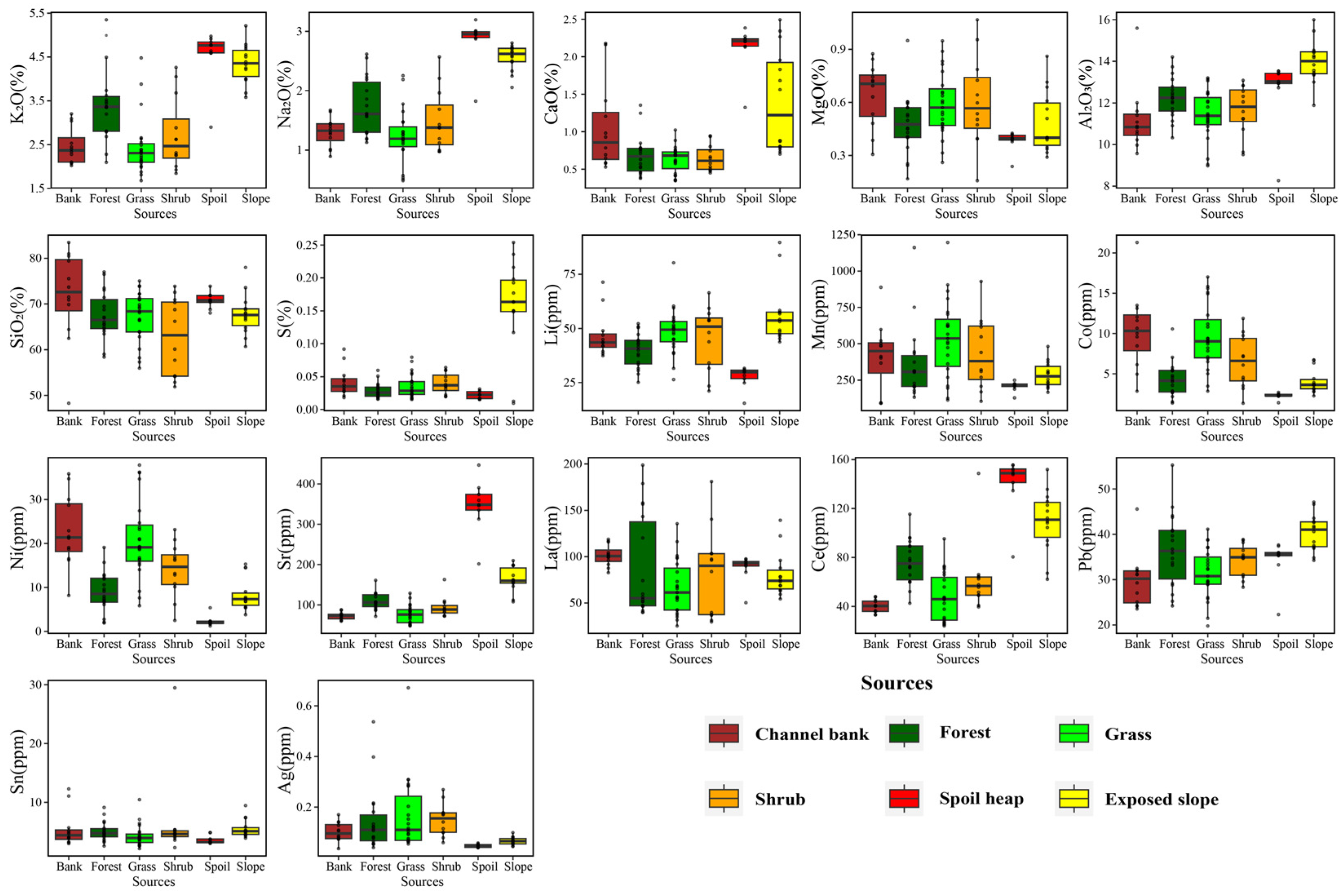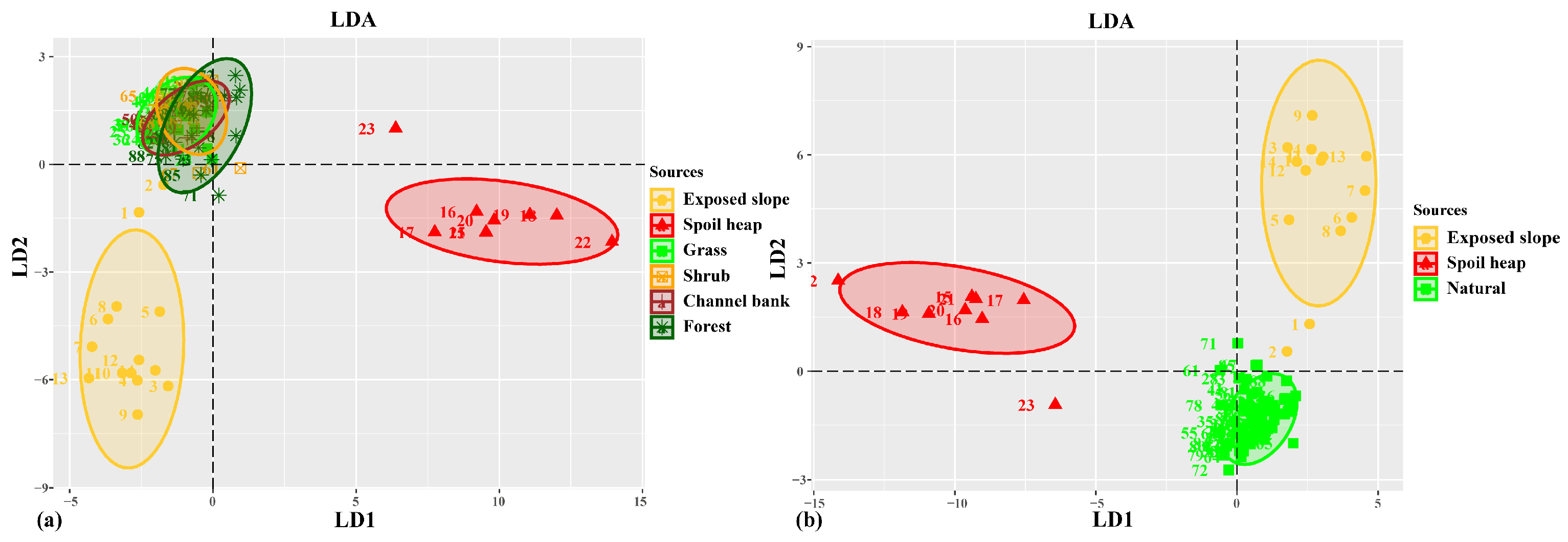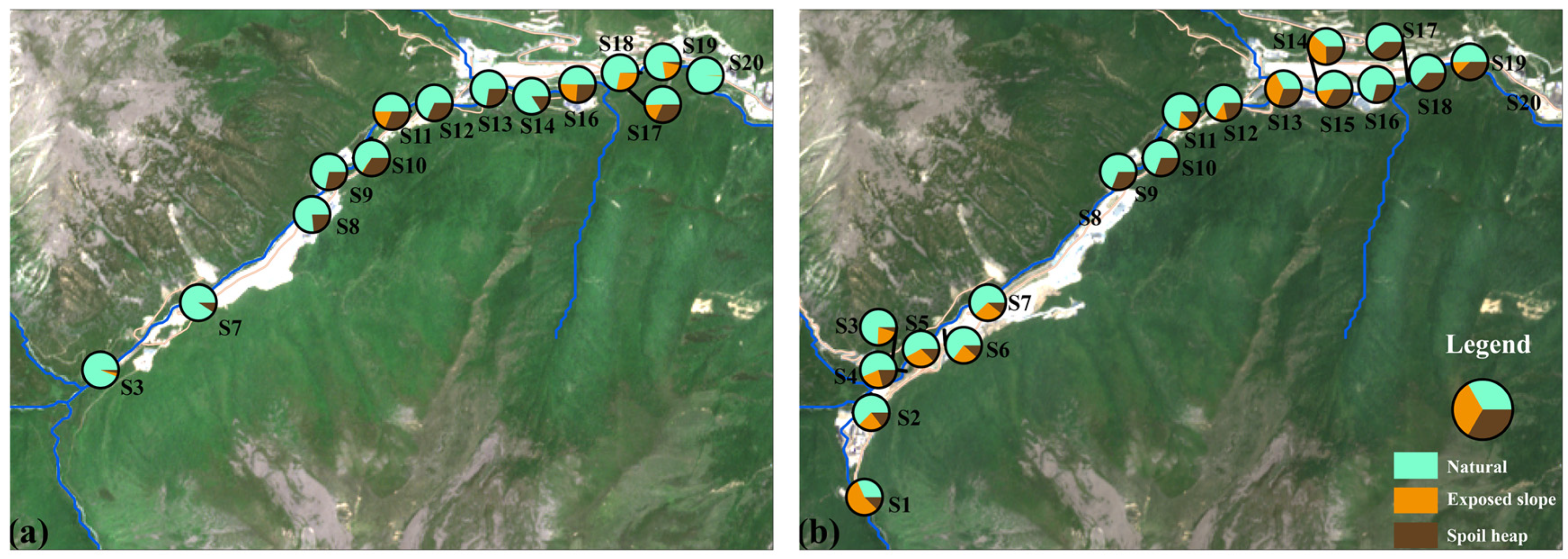Spatiotemporal Variations in Fingerprinting Sediment Sources in a Watershed Disturbed by Construction
Abstract
:1. Introduction
2. Materials and Methods
2.1. Study Area
2.2. Sediment Sources and Channel Deposition Sampling
2.3. Laboratory Analysis
2.4. Selection of Composite Fingerprints
2.4.1. Classification of Source Samples
2.4.2. Optimal Composite Fingerprints
- (1)
- Conservatism test
- (2)
- Kruskal‒Wallis H test and discriminant function analysis
2.5. Apportion of Sediment Sources
2.6. Disturbance Weighting Indicator
3. Results
3.1. Concentration of Fingerprints in the Sources and Source Classification
3.2. Selection of the Optimal Composite Fingerprints
3.3. Spatiotemporal Variation in Sources and Their Contributions to Sediment Deposition
3.3.1. Sediment Source Contribution in 2022 and 2023
3.3.2. Spatial Variation in Sediment Source Contributions
4. Discussion
4.1. Proportion of Different Sources in Sediment Deposition
4.2. Spatial Variations in the Sediment Contribution Rates from Engineering Disturbances
5. Conclusions
Author Contributions
Funding
Data Availability Statement
Conflicts of Interest
References
- Kopittke, P.M.; Minasny, B.; Pendall, E.; Rumpel, C.; McKenna, B.A. Healthy soil for healthy humans and a healthy planet. Crit. Rev. Environ. Sci. Technol. 2024, 54, 210–221. [Google Scholar] [CrossRef]
- Wang, J.Z.; Zhen, J.N.; Hu, W.F.; Chen, S.C.; Lizaga, I.; Zeraatpisheh, M.; Yang, X.D. Remote sensing of soil degradation: Progress and perspective. Int. Soil Water Conserv. Res. 2023, 11, 429–454. [Google Scholar] [CrossRef]
- Li, Z.Y.; Fang, H.Y. Impacts of climate change on water erosion: A review. Earth-Sci. Rev. 2016, 163, 94–117. [Google Scholar] [CrossRef]
- Malhotra, K.; Lamba, J.; Shepherd, S. Sources of stream bed sediment in an urbanized watershed. Catena 2020, 184, 104228. [Google Scholar] [CrossRef]
- Xu, Z.; Belmont, P.; Brahney, J.; Gellis, A.C. Sediment source fingerprinting as an aid to large-scale landscape conservation and restoration: A review for the Mississippi River Basin. J. Environ. Manag. 2022, 324, 116260. [Google Scholar] [CrossRef]
- Collins, A.L.; Walling, D.E. Documenting catchment suspended sediment sources: Problems, approaches and prospects. Prog. Phys. Geogr. 2004, 28, 159–196. [Google Scholar] [CrossRef]
- Collins, A.L.; Zhang, Y.; McChesney, D.; Walling, D.E.; Haley, S.M.; Smith, P. Sediment source tracing in a lowland agricultural catchment in southern England using a modified procedure combining statistical analysis and numerical modelling. Sci. Total Environ. 2012, 414, 301–317. [Google Scholar] [CrossRef]
- Gaspar, L.; Lizaga, I.; Blake, W.H.; Latorre, B.; Quijano, L.; Navas, A. Fingerprinting changes in source contribution for evaluating soil response during an exceptional rainfall in Spanish pre-pyrenees. J. Environ. Manag. 2019, 240, 136–148. [Google Scholar] [CrossRef] [PubMed]
- Lizaga, I.; Gaspar, L.; Latorre, B.; Navas, A. Variations in transport of suspended sediment and associated elements induced by rainfall and agricultural cycle in a Mediterranean agroforestry catchment. J. Environ. Manag. 2020, 272, 111020. [Google Scholar] [CrossRef]
- Pulley, S.; Collins, A.L. The potential for colour to provide a robust alternative to high-cost sediment source fingerprinting: Assessment using eight catchments in England. Sci. Total Environ. 2021, 792, 148416. [Google Scholar] [CrossRef] [PubMed]
- Gellis, A.C.; Fuller, C.C.; Van Metre, P.; Filstrup, C.T.; Tomer, M.D.; Cole, K.J.; Sabitov, T.Y. Combining sediment fingerprinting with age-dating sediment using fallout radionuclides for an agricultural stream, Walnut Creek, Iowa, USA. J. Soils Sediments 2019, 19, 3374–3396. [Google Scholar] [CrossRef]
- Kemper, J.T.; Rathburn, S.L.; Friedman, J.M.; Nelson, J.M.; Mueller, E.R.; Vincent, K.R. Fingerprinting historical tributary contributions to floodplain sediment using bulk geochemistry. Catena 2022, 214, 106231. [Google Scholar] [CrossRef]
- Zhang, X.C.; Liu, B.L. Using multiple composite fingerprints to quantify fine sediment source contributions: A new direction. Geoderma 2016, 268, 108–118. [Google Scholar] [CrossRef]
- Chen, F.X.; Wang, X.Y.; Li, X.X.; Wang, J.L.; Xie, D.T.; Ni, J.P.; Liu, Y.J. Using the sediment fingerprinting method to identify the sediment sources in small catchments with similar geological conditions. Agric. Ecosyst. Environ. 2019, 286, 106655. [Google Scholar] [CrossRef]
- Fathabadi, A.; Jansen, J.D. Quantifying uncertainty of sediment fingerprinting mixing models using frequentist and Bayesian methods: A case study from the Iranian loess Plateau. Catena 2022, 217, 106474. [Google Scholar] [CrossRef]
- Nosrati, K.; Akbari-Mahdiabad, M.; Ayoubi, S.; Collins, A.L. An exploratory study on the use of different composite magnetic and colour fingerprints in aeolian sediment provenance fingerprinting. Catena 2021, 200, 105182. [Google Scholar] [CrossRef]
- Zhang, J.; Yang, M.; Zhang, F.; Zhang, W.; Zhao, T.; Li, Y. Fingerprinting Sediment Sources After an Extreme Rainstorm Event in a Small Catchment on the Loess Plateau, PR China. Land Degrad. Dev. 2017, 28, 2527–2539. [Google Scholar] [CrossRef]
- Liu, Y.; Walling, D.; Yang, M.Y.; Zhang, F.B. Sediment source fingerprinting and the temporal variability of source contributions. J. Environ. Manag. 2023, 338, 117835. [Google Scholar] [CrossRef] [PubMed]
- Lizaga, I.; Latorre, B.; Bodé, S.; Gaspar, L.; Boeckx, P.; Navas, A. Combining isotopic and elemental tracers for enhanced sediment source partitioning in complex catchments. J. Hydrol. 2024, 631, 130768. [Google Scholar] [CrossRef]
- Patault, E.; Alary, C.; Franke, C.; Abriak, N.E. Quantification of tributaries contributions using a confluence-based sediment fingerprinting approach in the Canche river watershed (France). Sci. Total Environ. 2019, 668, 457–469. [Google Scholar] [CrossRef]
- Xiong, J.F.; Lin, C.; Ma, R.H.; Wu, Z.P.; Chen, L. Tracing sediment sources in a plain river network area by using optimized experimental design and reflectance spectroscopy. Water Res. 2024, 250, 121041. [Google Scholar] [CrossRef]
- Frankl, A.; Evrard, O.; Cammeraat, E.; Tytgat, B.; Verleyen, E.; Stokes, A. Tracing hotspots of soil erosion in high mountain environments: How forensic science based on plant eDNA can lead the way. An opinion. Plant Soil 2022, 476, 729–742. [Google Scholar] [CrossRef]
- Pulley, S.; Collins, A.L. Soil erosion, sediment sources, connectivity and suspended sediment yields in UK temperate agricultural catchments: Discrepancies and reconciliation of field-based measurements. J. Environ. Manag. 2024, 351, 119810. [Google Scholar] [CrossRef] [PubMed]
- Astorga, R.T.; Garcias, Y.; Borgatello, G.; Velasco, H.; Padilla, R.; Dercon, G.; Mabit, L. Use of geochemical fingerprints to trace sediment sources in an agricultural catchment of Argentina. Int. Soil Water Conserv. Res. 2020, 8, 410–417. [Google Scholar] [CrossRef]
- Nosrati, K.; Collins, A.L. Investigating the importance of recreational roads as a sediment source in a mountainous catchment using a fingerprinting procedure with different multivariate statistical techniques and a Bayesian un-mixing model. J. Hydrol. 2019, 569, 506–518. [Google Scholar] [CrossRef]
- Panagos, P.; Imeson, A.; Meusburger, K.; Borrelli, P.; Poesen, J.; Alewell, C. Soil Conservation in Europe: Wish or Reality? Land Degrad. Dev. 2016, 27, 1547–1551. [Google Scholar] [CrossRef]
- Zhang, L.T.; Gao, Z.L.; Yang, S.W.; Li, Y.H.; Tian, H.W. Dynamic processes of soil erosion by runoff on engineered landforms derived from expressway construction: A case study of typical steep spoil heap. Catena 2015, 128, 108–121. [Google Scholar] [CrossRef]
- Cheng, B.; Lv, Y.; Zhan, Y.; Su, D.; Cao, S. Constructing China’s Roads as Works of Art: A Case Study of “Esthetic Greenway” Construction in the Shennongjia Region of China. Land Degrad. Dev. 2015, 26, 324–330. [Google Scholar] [CrossRef]
- Hancock, G.R.; Crawter, D.; Fityus, S.G.; Chandler, J.; Wells, T. The measurement and modelling of rill erosion at angle of repose slopes in mine spoil. Earth Surf. Process. Landf. 2008, 33, 1006–1020. [Google Scholar] [CrossRef]
- Lv, J.R.; Luo, H.; Xie, Y.S. Impact of rock fragment size on erosion process and micro-topography evolution of cone-shaped spoil heaps. Geomorphology 2020, 350, 106936. [Google Scholar] [CrossRef]
- Li, J.M.; Li, L.; Wang, W.L.; Kang, H.L.; Guo, M.M.; Huang, J.Q.; Wang, Y.F.; Lou, Y.B.; Tong, X.X.; Nie, H.Y. Hydrological and erosion responses of steep spoil heaps to taproot and fibrous root grasses under simulated rainfalls. J. Hydrol. 2023, 618, 129169. [Google Scholar] [CrossRef]
- Bravo-Linares, C.; Ovando-Fuentealba, L.; Muñoz-Arcos, E.; Kitch, J.L.; Millward, G.E.; López-Gajardo, R.; Cañoles-Zambrano, M.; Del Valle, A.; Kelly, C.; Blake, W.H. Basin scale sources of siltation in a contaminated hydropower reservoir. Sci. Total Environ. 2024, 914, 169952. [Google Scholar] [CrossRef] [PubMed]
- Franz, C.; Makeschin, F.; Weiss, H.; Lorz, C. Sediments in urban river basins: Identification of sediment sources within the Lago Paranoa catchment, Brasilia DF, Brazil—Using the fingerprint approach. Sci. Total Environ. 2014, 466–467, 513–523. [Google Scholar] [CrossRef] [PubMed]
- Koiter, A.J.; Lobb, D.A.; Owens, P.N.; Petticrew, E.L.; Tiessen, K.H.D.; Li, S. Investigating the role of connectivity and scale in assessing the sources of sediment in an agricultural watershed in the Canadian prairies using sediment source fingerprinting. J. Soils Sediments 2013, 13, 1676–1691. [Google Scholar] [CrossRef]
- Li, Z.H.; Luo, Z.H.; Chen, Y.L.; Zhao, J.X. Geology and Geochemistry of the Kangding-Luding Metamorphosed Intrusions and Implication for Tectonic Setting. Geoscience 2008, 22, 181–189. Available online: https://www.geoscience.net.cn/CN/Y2008/V22/I2/181 (accessed on 2 May 2024).
- Collins, A.L.; Pulley, S.; Foster, I.D.L.; Gellis, A.; Porto, P.; Horowitz, A.J. Sediment source fingerprinting as an aid to catchment management: A review of the current state of knowledge and a methodological decision-tree for end-users. J. Environ. Manag. 2017, 194, 86–108. [Google Scholar] [CrossRef] [PubMed]
- Pulley, S.; Foster, I.; Collins, A.L. The impact of catchment source group classification on the accuracy of sediment fingerprinting outputs. J. Environ. Manag. 2017, 194, 16–26. [Google Scholar] [CrossRef] [PubMed]
- Lizaga, I.; Bodé, S.; Gaspar, L.; Latorre, B.; Boeckx, P.; Navas, A. Legacy of historic land cover changes on sediment provenance tracked with isotopic tracers in a Mediterranean agroforestry catchment. J. Environ. Manag. 2021, 288, 112291. [Google Scholar] [CrossRef] [PubMed]
- Lizaga, I.; Latorre, B.; Gaspar, L.; Navas, A. FingerPro: An R Package for Tracking the Provenance of Sediment. Water Resour. Manag. 2020, 34, 3879–3894. [Google Scholar] [CrossRef]
- Walling, D.E.; Russell, M.A.; Hodgkinson, R.A.; Zhang, Y. Establishing sediment budgets for two small lowland agricultural catchments in the UK. Catena 2002, 47, 323–353. [Google Scholar] [CrossRef]
- Collins, A.L.; Walling, D.E.; Leeks, G.J.L. Source type ascription for fluvial suspended sediment based on a quantitative composite fingerprinting technique. Catena 1997, 29, 1–27. [Google Scholar] [CrossRef]
- Walling, D.E.; Owens, P.N.; Leeks, G.J.L. Fingerprinting suspended sediment sources in the catchment of the River Ouse, Yorkshire, UK. Hydrol. Process. 1999, 13, 955–975. [Google Scholar] [CrossRef]
- Motha, J.A.; Wallbrink, P.J.; Hairsine, P.B.; Grayson, R.B. Determining the sources of suspended sediment in a forested catchment in southeastern Australia. Water Resour. Res. 2003, 39, 1056. [Google Scholar] [CrossRef]
- Gorman Sanisaca, L.; Gellis, A.; Lorenz, D. Sediment Source Assessment Tool (Sed_SAT). Available online: https://www.usgs.gov/software/sediment-source-assessment-tool-sedsat (accessed on 6 June 2024).
- Shu, C.B.; Liu, G.; Zhang, Q.; Xu, J.H.; Chen, H.; Dan, C.X.; Wang, X.K.; Shen, Y.L.; Liu, Y.; Guo, Z.; et al. Fingerprinting sediment sources in mountainous catchments disturbed by plantation and construction activities in southern China. Land Degrad. Dev. 2024, 35, 3287–3301. [Google Scholar] [CrossRef]
- Zhou, H.P.; Chang, W.N.; Zhang, L.J. Sediment sources in a small agricultural catchment: A composite fingerprinting approach based on the selection of potential sources. Geomorphology 2016, 266, 11–19. [Google Scholar] [CrossRef]
- Ferreira, C.S.S.; Walsh, R.P.D.; Blake, W.H.; Kikuchi, R.; Ferreira, A.J.D. Temporal Dynamics of Sediment Sources in an Urbanizing Mediterranean Catchment. Land Degrad. Dev. 2017, 28, 2354–2369. [Google Scholar] [CrossRef]
- Malhotra, K.; Lamba, J.; Srivastava, P.; Shepherd, S. Fingerprinting Suspended Sediment Sources in an Urbanized Watershed. Water 2018, 10, 1573. [Google Scholar] [CrossRef]
- Laceby, J.P.; Evrard, O.; Smith, H.G.; Blake, W.H.; Olley, J.M.; Minella, J.P.G.; Owens, P.N. The challenges and opportunities of addressing particle size effects in sediment source fingerprinting: A review. Earth-Sci. Rev. 2017, 169, 85–103. [Google Scholar] [CrossRef]
- Collins, A.L.; Blackwell, M.; Boeckx, P.; Chivers, C.A.; Emelko, M.; Evrard, O.; Foster, I.; Gellis, A.; Gholami, H.; Granger, S.; et al. Sediment source fingerprinting: Benchmarking recent outputs, remaining challenges and emerging themes. J. Soils Sediments 2020, 20, 4160–4193. [Google Scholar] [CrossRef]
- Zhang, H.G.; Jiang, Z.L. Research on Soil Conservation During the Dadu River Valley Construction. Res. Soil Water Conserv. 2005, 12, 46–48. Available online: http://stbcyj.paperonce.org/oa/darticle.aspx?id=20050214 (accessed on 2 May 2024).
- Huang, X.T.; Zheng, H.B.; John, C.; Wang, P. Characteristics of cosmogenic nuclide 10 Be in the Yangtze riverine sediments and estimations of erosion rate. Quat. Sci. 2013, 33, 671–683. [Google Scholar] [CrossRef]
- Cui, P.; Wang, D.J.; Fan, J.R.; Wang, Y.K.; He, X.B.; Zhu, B.; Wei, F.Q.; Wang, G.X. Current status and comprehensive control strategies of soil erosion for the upper Yangtze and other rivers in the Southwestern China. Sci. Soil Water Conserv. 2008, 6, 43–50. [Google Scholar] [CrossRef]
- Guo, Q.K.; Shan, Z.J.; Lu, W.; Qin, W.; Yin, Z.; Xu, H.C. Fingerprinting sediment sources in two typical watersheds in the dry-hot valleys of Southwest China: The role of gully and orchard land. Catena 2023, 233, 107479. [Google Scholar] [CrossRef]
- Shi, Z.L.; Blake, W.H.; Wen, A.B.; Chen, J.C.; Yan, D.C.; Long, Y. Channel erosion dominates sediment sources in an agricultural catchment in the Upper Yangtze basin of China: Evidence from geochemical fingerprints. Catena 2021, 199, 105111. [Google Scholar] [CrossRef]
- Faucette, L.B.; Risse, L.M.; Jordan, C.F.; Cabrera, M.L.; Coleman, D.C.; West, L.T. Vegetation and soil quality effects from hydroseed and compost blankets used for erosion control in construction activities. J. Soil Water Conserv. 2006, 61, 355–362. Available online: https://www.jswconline.org/content/jswc/61/6/355 (accessed on 2 May 2024).
- Harbor, J. Engineering geomorphology at the cutting edge of land disturbance: Erosion and sediment control on construction sites. Geomorphology 1999, 31, 247–263. [Google Scholar] [CrossRef]
- Jenny, J.P.; Koirala, S.; Gregory-Eaves, I.; Francus, P.; Niemann, C.; Ahrens, B.; Brovkin, V.; Baud, A.; Ojala, A.E.K.; Normandeau, A.; et al. Human and climate global-scale imprint on sediment transfer during the Holocene. Proc. Natl. Acad. Sci. USA 2019, 116, 22972–22976. [Google Scholar] [CrossRef]
- Li, J.M.; Wang, W.L.; Guo, M.M.; Kang, H.L.; Wang, Z.G.; Huang, J.Q.; Sun, B.Y.; Wang, K.; Zhang, G.H.; Bai, Y. Effects of soil texture and gravel content on the infiltration and soil loss of spoil heaps under simulated rainfall. J. Soils Sediments 2020, 20, 3896–3908. [Google Scholar] [CrossRef]
- Su, H.; Wang, W.L.; Kang, H.L.; Bai, Y.; Guo, M.M.; Chen, Z.X. Erosion morphology and the characteristics of runoff and sediment yielding in platform-slope system of opencast coal mine. Chin. J. Appl. Ecol. 2020, 31, 3194–3206. [Google Scholar] [CrossRef]
- Li, X.; Zhu, B.C.; Cao, L.X.; Li, R.; Bai, C.L.; Wang, X.J. Composite Fingerprint Analysis of Sediment Sources in a Watershed Disturbed by Road Construction in Southeastern Tibet. Land 2024, 13, 929. [Google Scholar] [CrossRef]
- Song, X.; Xu, L.W.; He, X.L.; Cao, P.J. Ganzi Tibetan Autonomous Prefecture Water Resources Report 2022; Ganzi Water Authority: Kangding, China, 2023; p. 27. Available online: https://slj.gzz.gov.cn/tzgs/article/533041 (accessed on 2 May 2024).
- Huang, Z.; Lin, B.L.; Sun, J.; Nima, L.Z.; Da, P.; Dawa, J.M. Suspended Sediment Transport Responses to Increasing Human Activities in a High-Altitude River: A Case Study in a Typical Sub-Catchment of the Yarlung Tsangpo River. Water 2020, 12, 952. [Google Scholar] [CrossRef]
- Cao, L.X.; Elliot, W.; Long, J.W. Spatial simulation of forest road effects on hydrology and soil erosion after a wildfire. Hydrol. Process. 2021, 35, e14139. [Google Scholar] [CrossRef]
- Li, X.; Shi, M.M.; Cao, L.X.; Chen, G.; Wang, Y.; Yao, L.F. A composite fingerprinting analysis of sediment sources in a construction-disturbed small watersheds of Southeast Tibet. Sci. Soil Water Conserv. 2023, 21, 113–122. [Google Scholar] [CrossRef]
- Elliot, W.J. WEPP internet interfaces for forest erosion prediction. J. Am. Water Resour. Assoc. 2004, 40, 299–309. [Google Scholar] [CrossRef]
- Robichaud, P.R.; Storrar, K.A.; Wagenbrenner, J.W. Effectiveness of straw bale check dams at reducing post-fire sediment yields from steep ephemeral channels. Sci. Total Environ. 2019, 676, 721–731. [Google Scholar] [CrossRef]





| Tracers | Sources | Sediment | Kruskal–Wallis H-Test | |||||
|---|---|---|---|---|---|---|---|---|
| Min | Max | Mean | Min | Max | Mean | p Value | ||
| Tracer01 | K2O | 1.7 | 5.3 | 3.2 | 2.1 | 4.8 | 3.2 | 0.000 a* |
| Tracer02 | Na2O | 0.5 | 3.2 | 1.8 | 1 | 3.1 | 1.9 | 0.000 a* |
| Tracer03 | CaO | 0.3 | 2.5 | 1.0 | 0.5 | 4.9 | 2.9 | |
| Tracer04 | MgO | 0.2 | 1.1 | 0.5 | 0.4 | 0.8 | 0.6 | 0.003 a* |
| Tracer05 | Al2O3 | 8.3 | 16.0 | 12.1 | 10.5 | 13.8 | 11.5 | 0.000 a* |
| Tracer06 | SiO2 | 48.3 | 83.5 | 67.8 | 66.5 | 80.8 | 73.6 | 0.176 a |
| Tracer07 | S | 0.009 | 0.25 | 0.1 | 0.006 | 0.23 | 0.081 | |
| Tracer08 | Li | 15.5 | 89.7 | 45.2 | 31.1 | 48.7 | 39.1 | 0.000 a* |
| Tracer09 | Mn | 91.3 | 1196.8 | 395.8 | 186.3 | 1075.8 | 387.9 | 0.004 a* |
| Tracer10 | Co | 1.4 | 21.3 | 6.6 | 2.2 | 11.1 | 6.2 | 0.000 a* |
| Tracer11 | Ni | 1.2 | 37.8 | 13.9 | 4.2 | 29.2 | 15.7 | 0.000 a* |
| Tracer12 | Sr | 47.9 | 446.6 | 126.2 | 87.1 | 203.3 | 148.6 | 0.000 a* |
| Tracer13 | La | 25.3 | 198.8 | 82.0 | 33 | 216.2 | 76.1 | |
| Tracer14 | Ce | 24.0 | 155.5 | 73.8 | 51.8 | 132.1 | 86.7 | 0.000 a* |
| Tracer15 | Pb | 19.8 | 55.3 | 34.3 | 22.2 | 33.9 | 28.7 | 0.000 a* |
| Tracer16 | Sn | 2.1 | 29.5 | 5.0 | 2.6 | 14.4 | 4.6 | 0.004 a* |
| Tracer17 | Ag | 0.036 | 0.671 | 0.123 | 0.031 | 0.332 | 0.055 | |
| Tracer | Wilks Lambda | Cumulative Percentage Classified (%) | Individual Percentage Classified (%) |
|---|---|---|---|
| Sr | 0.1379 | 87.94 | 87.9 |
| Na2O | 0.0841 | 92.19 | 81.6 |
| Ce | 0.0650 | 92.70 | 77.4 |
| Li | 0.0494 | 93.73 | 70.3 |
| Sources | Predicted Sources | |||
|---|---|---|---|---|
| Natural | Exposed Slope | Spoil Heap | ||
| Actual | Natural | 60 | 0 | 1 |
| Exposed slope | 5 | 14 | 0 | |
| Spoil heap | 0 | 0 | 8 | |
| Count | Natural | 92.3 | 0 | 11.1 |
| % | Exposed slope | 7.7 | 100 | 0 |
| Spoil heap | 0 | 0 | 88.9 | |
| Period | Average Contribution (%) | Area (ha)/Proportion (%) | Average GOF | n | |||
|---|---|---|---|---|---|---|---|
| Natural | Exposed Slope | Spoil Heap | Exposed Slope | Spoil Heap | |||
| 2022 | 72.96 | 8.04 | 19.00 | 5.78/0.038 | 21.69/0.143 | 0.91 | 14 |
| 2023 | 58.73 | 18.36 | 22.91 | 13.99/0.093 | 31.23/0.206 | 0.88 | 18 |
Disclaimer/Publisher’s Note: The statements, opinions and data contained in all publications are solely those of the individual author(s) and contributor(s) and not of MDPI and/or the editor(s). MDPI and/or the editor(s) disclaim responsibility for any injury to people or property resulting from any ideas, methods, instructions or products referred to in the content. |
© 2024 by the authors. Licensee MDPI, Basel, Switzerland. This article is an open access article distributed under the terms and conditions of the Creative Commons Attribution (CC BY) license (https://creativecommons.org/licenses/by/4.0/).
Share and Cite
Zhu, B.; Cao, L.; Yang, S.; Pan, H.; Liu, F.; Kong, Y. Spatiotemporal Variations in Fingerprinting Sediment Sources in a Watershed Disturbed by Construction. Land 2024, 13, 1314. https://doi.org/10.3390/land13081314
Zhu B, Cao L, Yang S, Pan H, Liu F, Kong Y. Spatiotemporal Variations in Fingerprinting Sediment Sources in a Watershed Disturbed by Construction. Land. 2024; 13(8):1314. https://doi.org/10.3390/land13081314
Chicago/Turabian StyleZhu, Baicheng, Longxi Cao, Sen Yang, Heping Pan, Fei Liu, and Yaping Kong. 2024. "Spatiotemporal Variations in Fingerprinting Sediment Sources in a Watershed Disturbed by Construction" Land 13, no. 8: 1314. https://doi.org/10.3390/land13081314




